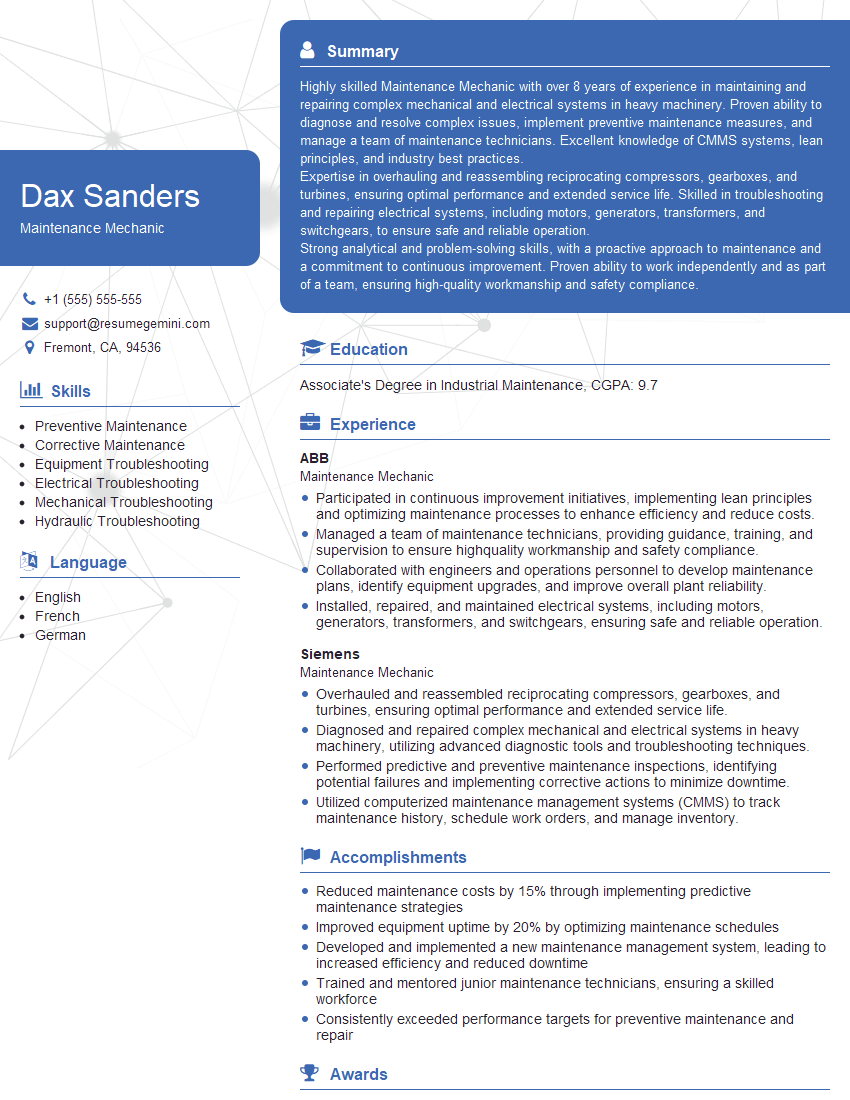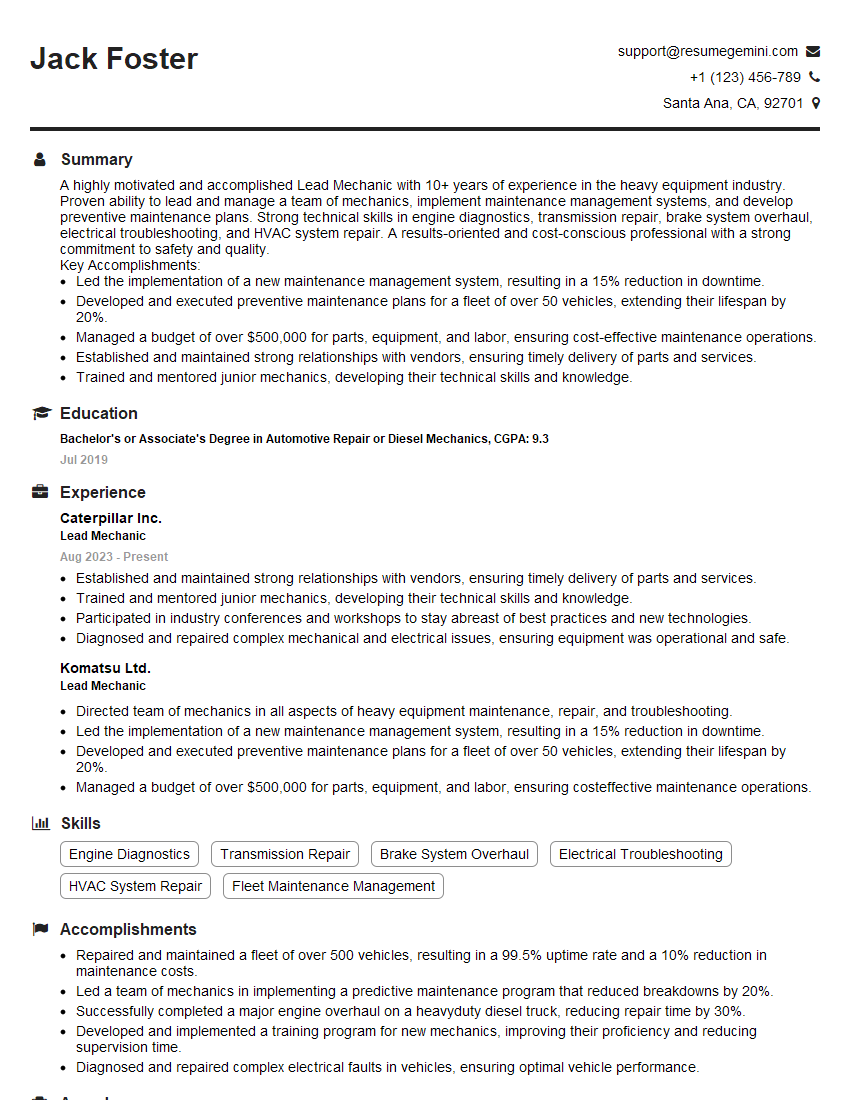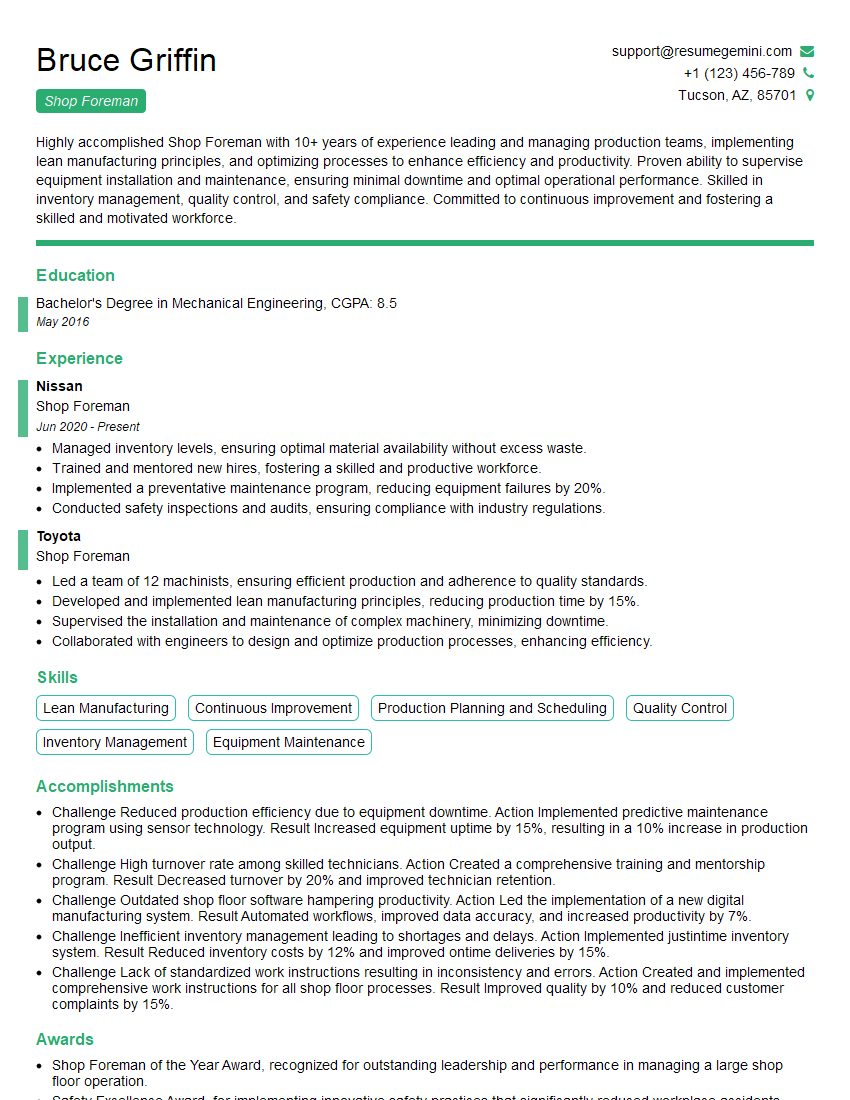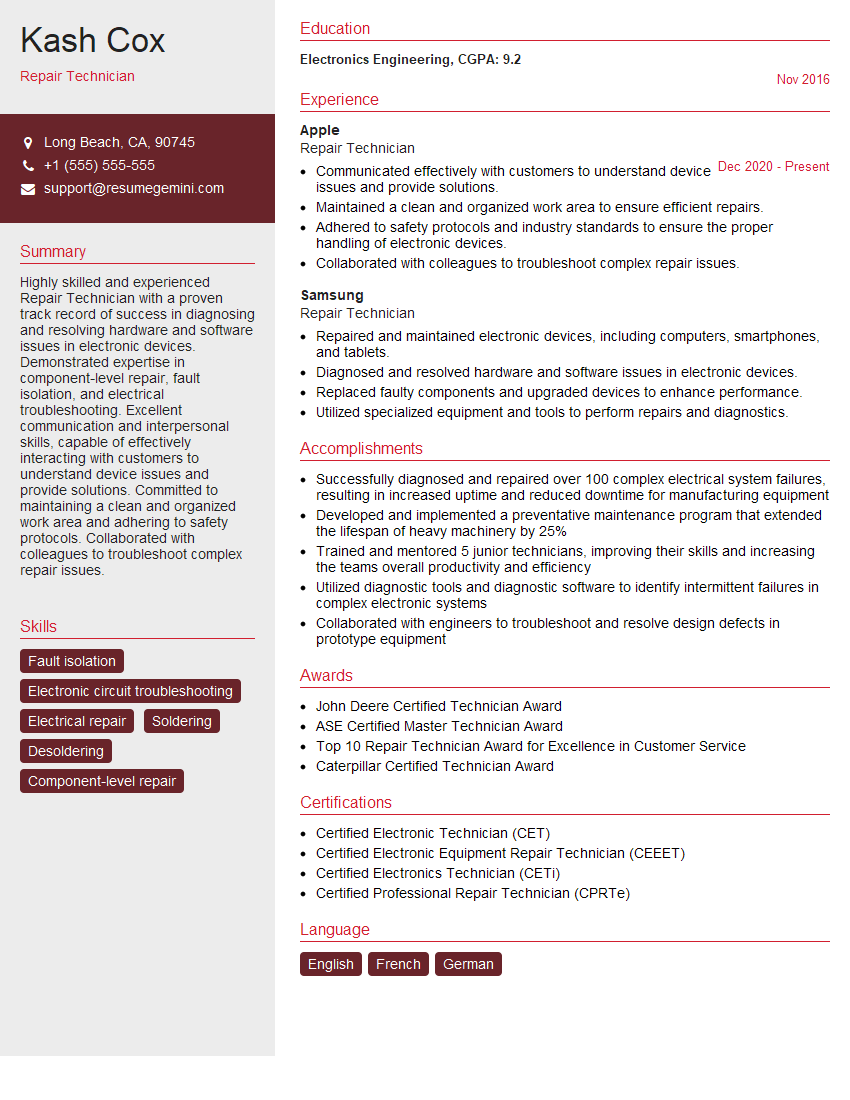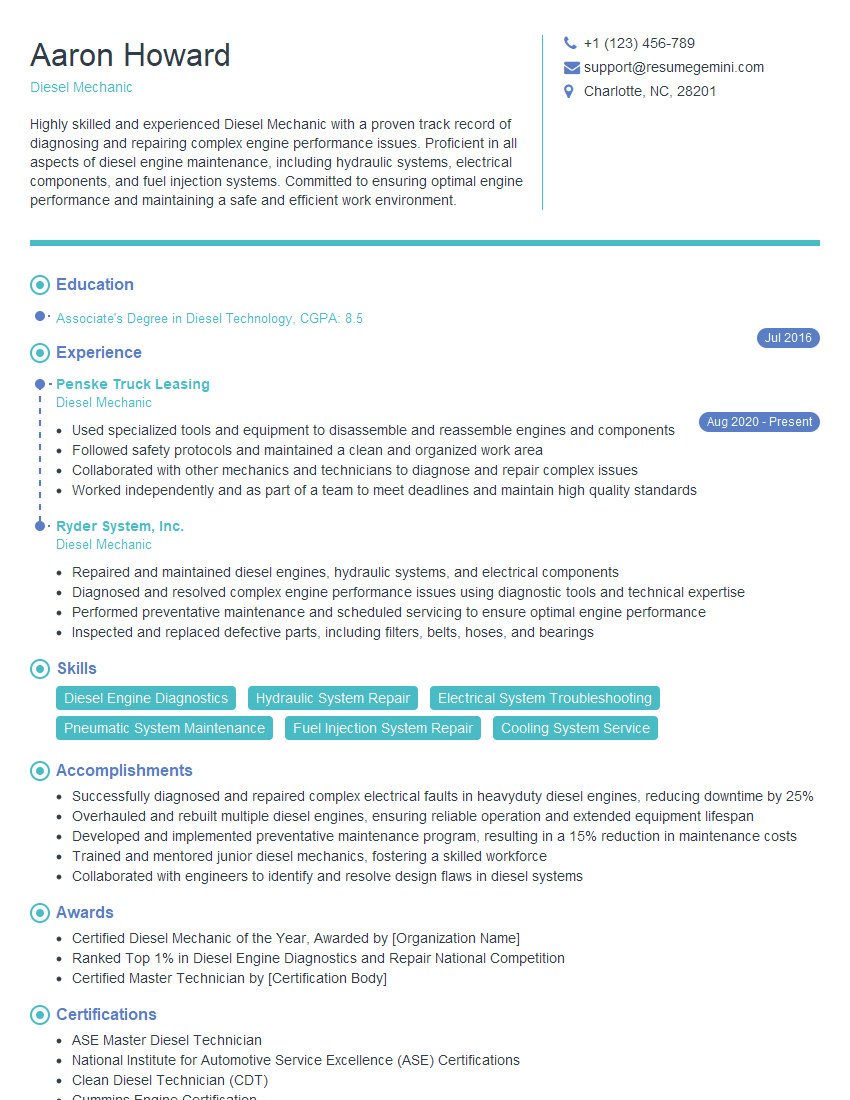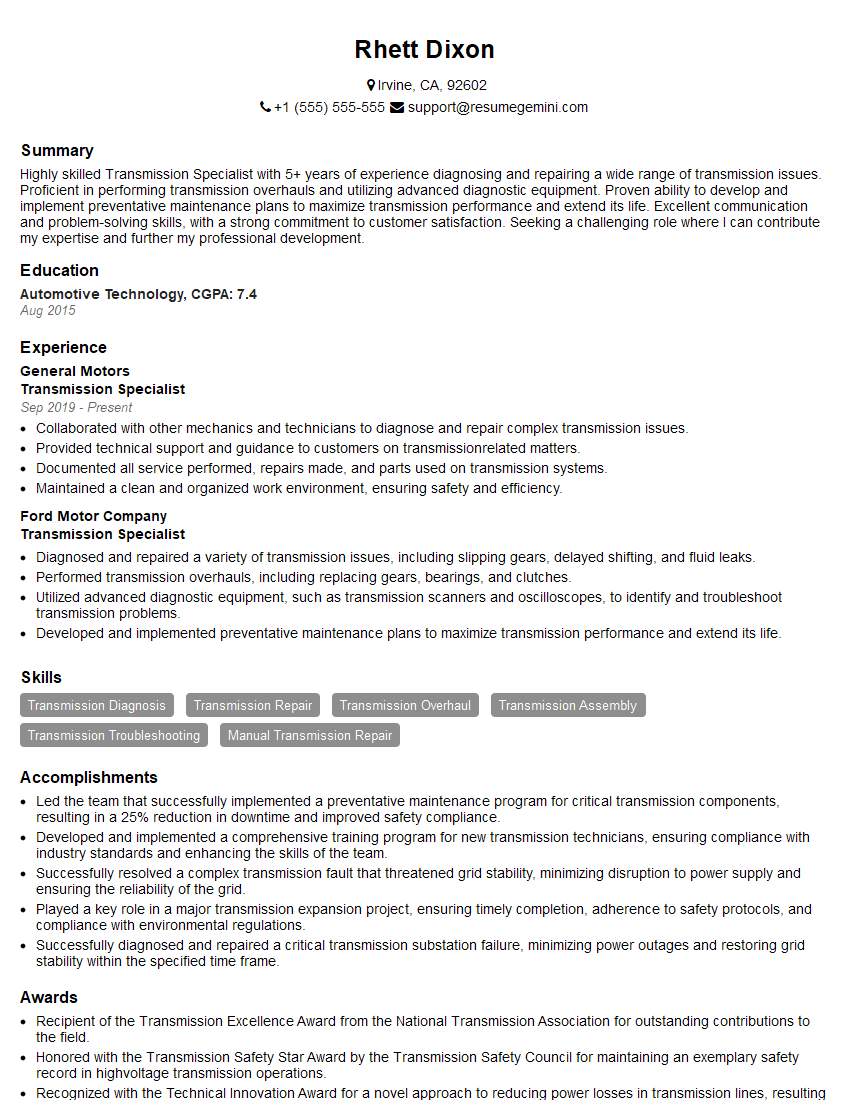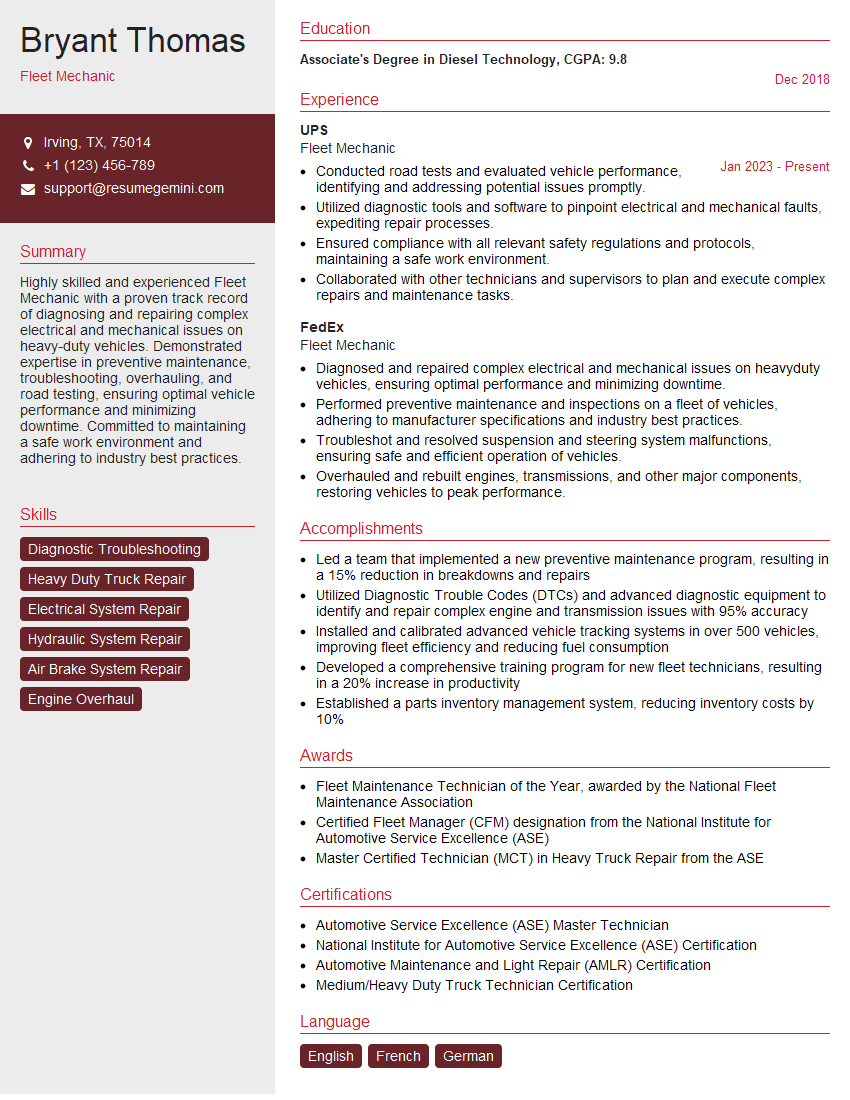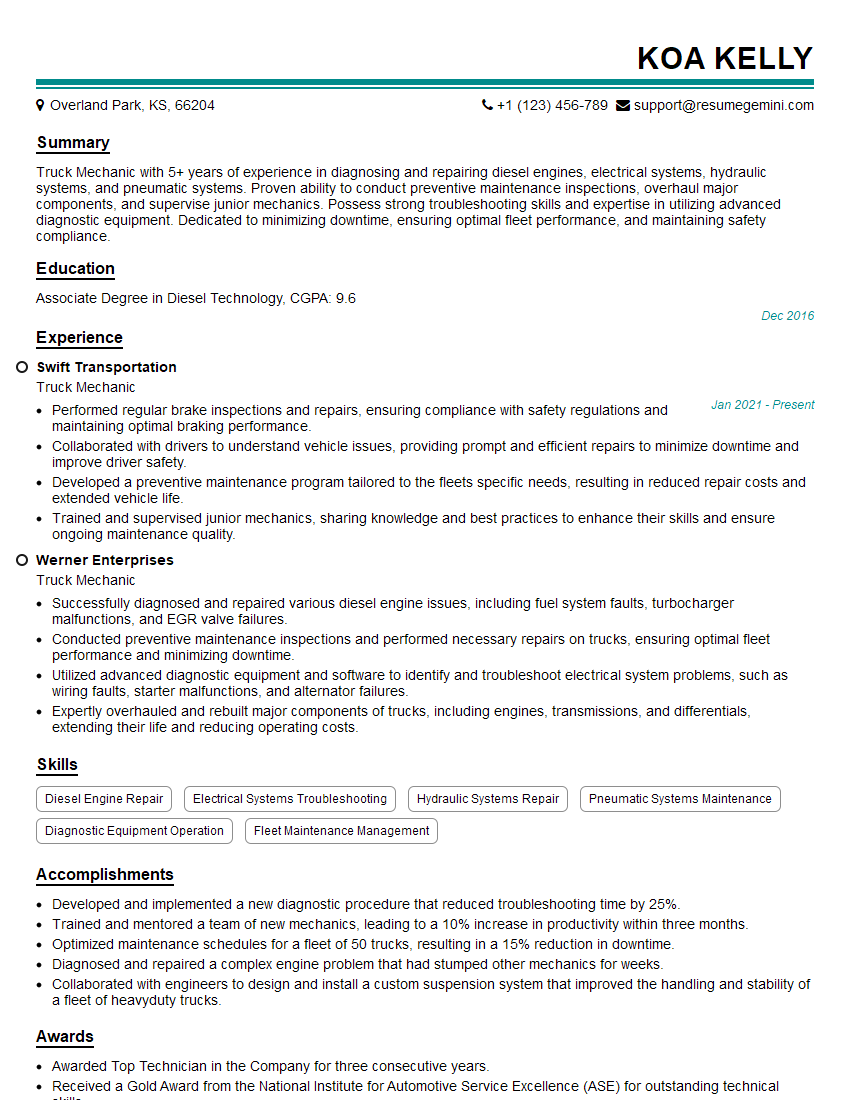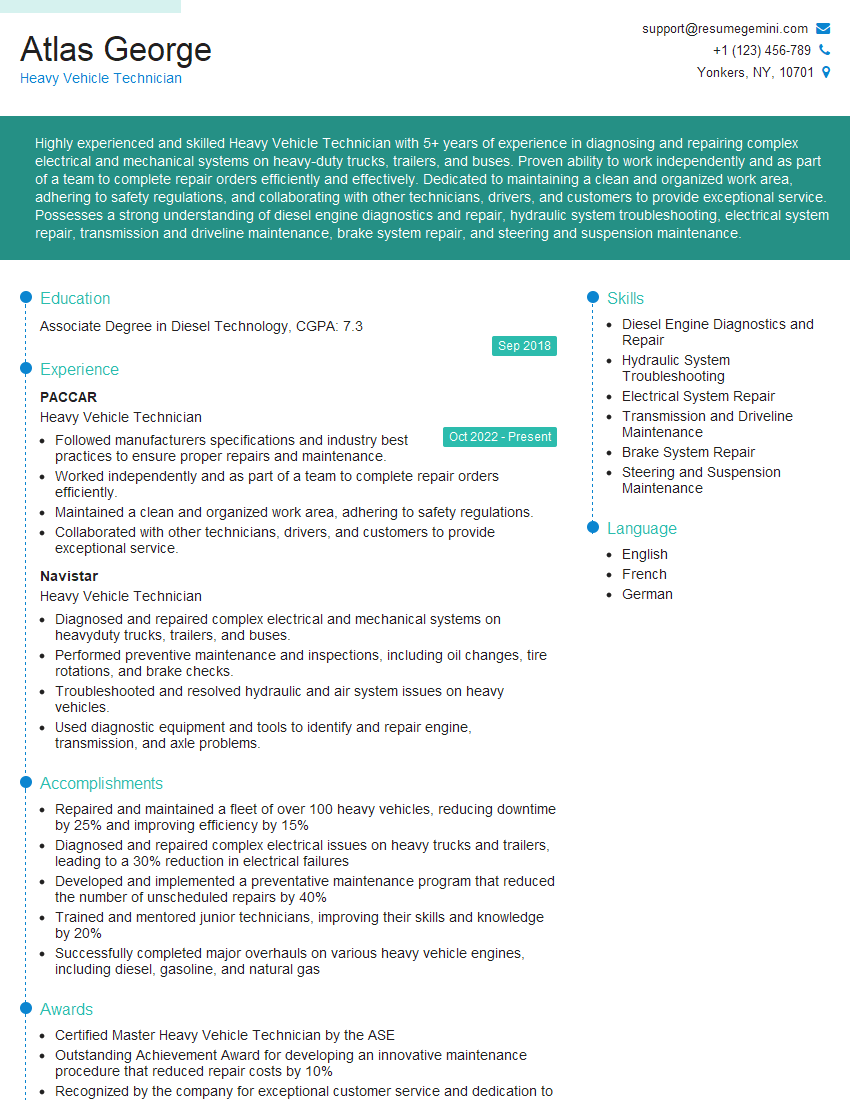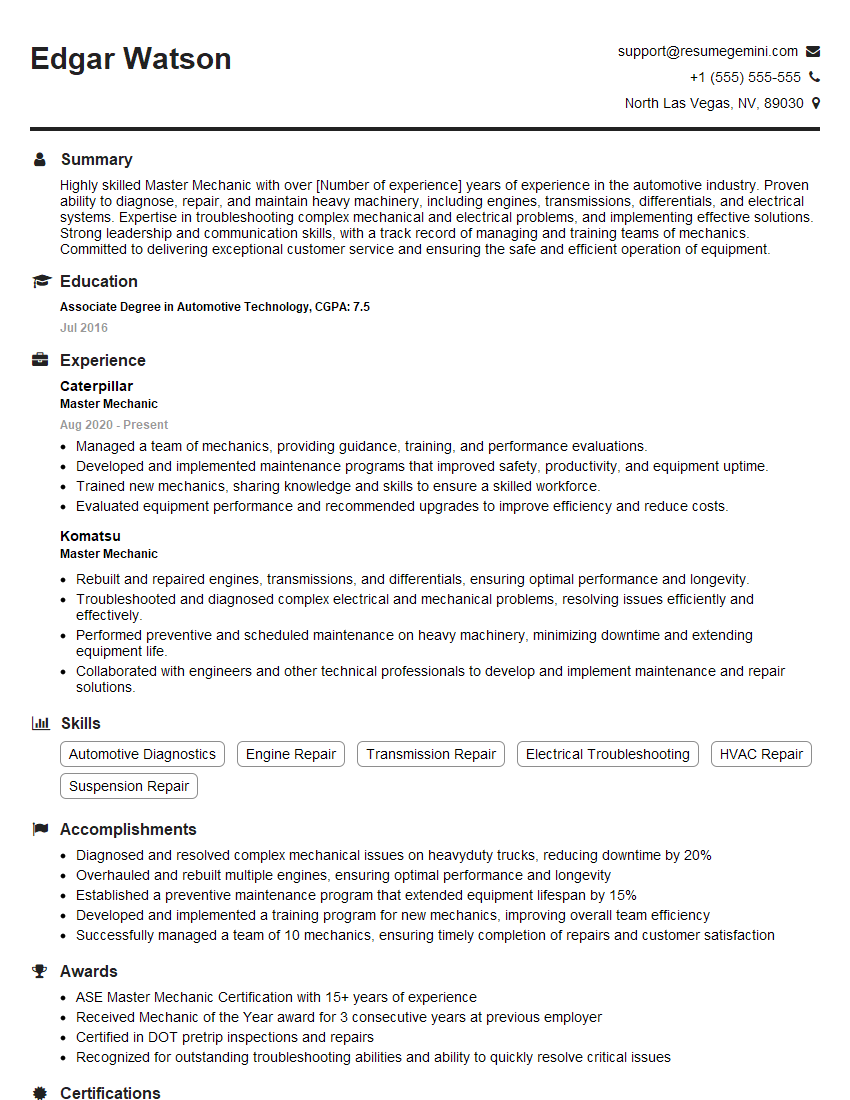Preparation is the key to success in any interview. In this post, we’ll explore crucial Truck and Bearing Repair interview questions and equip you with strategies to craft impactful answers. Whether you’re a beginner or a pro, these tips will elevate your preparation.
Questions Asked in Truck and Bearing Repair Interview
Q 1. Explain the different types of bearings used in heavy-duty trucks.
Heavy-duty trucks utilize several bearing types, each designed to withstand immense loads and vibrations. The most common are:
- Tapered Roller Bearings: These are the workhorses of truck axles, capable of handling both radial (weight) and thrust (forward/backward) loads. Think of them as a cone rolling inside a cup – this design allows for efficient load distribution. They’re prevalent in wheel hubs and transmissions.
- Ball Bearings: Primarily used in smaller components, like fan hubs and accessory drives, ball bearings excel in high-speed applications but usually handle less weight than tapered roller bearings. They consist of small balls rolling between inner and outer races.
- Spherical Roller Bearings: These are excellent for applications with misalignment, like some suspension systems. They allow for some angular deviation while still providing radial load support. Imagine a ball bearing that can self-align.
- Cylindrical Roller Bearings: These bearings support primarily radial loads and are found in applications requiring high load capacity and rigidity, such as certain transmission components. They feature cylindrical rollers instead of balls or tapered rollers.
The choice of bearing type depends on the specific application’s load requirements, speed, and operating conditions. For instance, a wheel hub experiences significant radial and thrust loads, necessitating a robust tapered roller bearing. Meanwhile, a fan hub might use a ball bearing due to its high rotational speed.
Q 2. Describe the process of inspecting a wheel bearing for damage.
Inspecting a wheel bearing involves a systematic approach to identify potential damage. First, visually inspect the bearing for any obvious signs of wear, such as:
- Rust or Corrosion: Significant rust can compromise bearing integrity.
- Damage to the Races: Check for pitting, scoring, or flaking on both the inner and outer races.
- Roller or Ball Damage: Look for chipped, flattened, or pitted rollers or balls.
- Seal Damage: Inspect the seals for cracks, tears, or leaks. A damaged seal allows contaminants to enter, leading to premature failure.
Beyond visual inspection, you can also check for play (loose movement) in the bearing. With the wheel removed, grab the hub and attempt to move it. Any noticeable play indicates bearing wear. A mechanic’s stethoscope can help to identify subtle noises indicative of bearing wear – a characteristic growling or rumbling sound. Remember, any questionable condition necessitates replacement.
Q 3. What are the common causes of bearing failure?
Bearing failure is often a result of a combination of factors, but common culprits include:
- Lack of Lubrication: Insufficient lubrication leads to excessive friction and heat, causing premature wear.
- Contamination: Dust, dirt, and water entering the bearing contaminate the lubricant and cause abrasive wear.
- Overloading: Exceeding the bearing’s load capacity can lead to permanent damage.
- Misalignment: Improper installation or misalignment of components can induce uneven stress on the bearing.
- Corrosion: Exposure to moisture or corrosive substances can degrade bearing materials.
- Impact Damage: Sudden impacts, like hitting a pothole, can damage the bearing’s internal components.
Often, it’s not a single cause but a combination of these factors that leads to bearing failure. For example, a seal leak allowing contamination coupled with inadequate lubrication will significantly shorten bearing life.
Q 4. How do you diagnose a bad bearing?
Diagnosing a bad bearing usually relies on a combination of observations and tests:
- Noise: A characteristic growling, rumbling, or whining sound, often increasing with speed, is a strong indicator of a failing bearing. Use a stethoscope to pinpoint the source of the noise.
- Vibration: Excessive vibration in the wheel or drivetrain suggests a problem. This can be felt through the steering wheel or seat.
- Play or Loose Movement: Excessive play in the wheel or hub indicates bearing wear.
- Heat: An unusually hot wheel hub points to increased friction and possible bearing failure.
- Grease Leakage: Grease leaking from the bearing seal is a clear sign of damage.
By systematically checking these aspects, you can often identify the faulty bearing. It’s important to note that some problems might manifest in subtle ways, warranting professional diagnosis in ambiguous cases.
Q 5. What tools and equipment are necessary for bearing replacement?
Replacing a wheel bearing requires specialized tools. Essential equipment includes:
- Wheel Hub Removal Tool: To safely remove the wheel hub assembly.
- Bearing Press: For safely installing and removing bearings without damaging them. A hydraulic press is ideal.
- Impact Wrench: For loosening and tightening wheel nuts.
- Torque Wrench: To tighten components to the manufacturer’s specified torque.
- Socket Set: Various sockets are needed to access different fasteners.
- Pry Bars: May be necessary for separating components.
- Grease Gun: For applying fresh lubricant.
- New Bearings and Seals: Always use the correct replacement parts.
Safety is paramount. Always use the correct safety equipment, including gloves and safety glasses, and follow proper procedures.
Q 6. Describe the steps involved in replacing a wheel bearing.
Replacing a wheel bearing is a complex procedure and should only be undertaken by trained professionals. The steps generally involve:
- Secure the Vehicle: Park the truck on a level surface, engage the parking brake, and chock the wheels.
- Remove the Wheel and Tire: Use an impact wrench to carefully remove the wheel nuts.
- Remove the Hub Assembly: Use the appropriate wheel hub removal tool.
- Remove the Old Bearing: Carefully press out the old bearing using a bearing press. Avoid damaging the hub.
- Clean the Hub: Thoroughly clean the hub to remove any debris or old grease.
- Install the New Bearing: Use a bearing press to install the new bearing, ensuring it’s properly seated.
- Install New Seals: Replace any worn or damaged seals.
- Reassemble the Hub: Carefully reassemble the hub, ensuring proper alignment.
- Install the Wheel and Tire: Tighten the lug nuts to the manufacturer’s specified torque.
- Test Drive: Conduct a test drive to verify proper operation. Listen carefully for any unusual noises.
Incorrect installation can lead to premature bearing failure or serious safety hazards. Always consult the vehicle’s service manual for precise instructions.
Q 7. How do you ensure proper bearing lubrication?
Proper bearing lubrication is crucial for extending bearing life. The key is using the right type and amount of grease and following proper procedures:
- Use the correct grease: Consult the vehicle’s service manual to determine the correct type of grease for the specific bearing. Using the wrong grease can lead to premature wear.
- Proper amount of grease: Overfilling can cause excessive heat and pressure. Underfilling leads to inadequate lubrication. The service manual will often provide guidelines for packing the bearing.
- Regular lubrication intervals: Follow the recommended lubrication schedule for your vehicle. Regular lubrication keeps the bearing clean and prevents wear.
- Proper grease gun technique: Ensure that the grease is properly pumped into the bearing, avoiding air pockets.
Think of grease as the lifeblood of the bearing; it keeps everything moving smoothly and prevents metal-on-metal contact. Neglecting lubrication is a surefire way to shorten bearing life significantly.
Q 8. What are the safety precautions when working with truck bearings?
Safety is paramount when working with truck bearings. These components handle significant loads and speeds; failure can lead to catastrophic consequences. Always begin by ensuring the truck is securely parked on a level surface, and the parking brake is engaged. Wear appropriate personal protective equipment (PPE), including safety glasses, gloves, and sturdy work boots. Disconnect the battery to prevent accidental electrical shocks. Use proper jack stands and wheel chocks for added safety when working under the vehicle. Never work under a vehicle supported only by a jack. When removing bearings, use specialized tools to prevent injury from sharp edges or flying debris. Clean the work area to prevent slipping and falls. Dispose of used oil and grease responsibly, following all environmental regulations.
Think of it like this: you wouldn’t attempt brain surgery without sterile equipment and protective gear. The same meticulous approach is necessary when handling truck bearings.
Q 9. Explain the importance of proper bearing preload.
Proper bearing preload is critical for optimal performance and longevity. Preload is the axial force applied to a bearing to eliminate play (clearance) between the rolling elements and races. Insufficient preload results in excessive play, causing noise, vibration, premature wear, and potential bearing failure. Excessive preload, on the other hand, increases friction, generates heat, and reduces bearing lifespan. The optimal preload depends on the specific bearing type, size, and application, often specified by the manufacturer. It’s determined during assembly and checked regularly using specialized measuring tools. Imagine a bicycle wheel – if the bearings are too loose, the wheel wobbles; if too tight, the wheel is difficult to turn. The same principle applies to truck wheel bearings, except the consequences of incorrect preload are far more severe.
Q 10. How do you identify different types of bearing damage (e.g., pitting, brinelling)?
Identifying bearing damage requires careful inspection. Pitting is characterized by small, crater-like indentations on the bearing raceways or rolling elements. This is often caused by fatigue, contamination, or improper lubrication. Brinelling appears as indentations or cracks on the raceways caused by excessive shock loads or impact. Fretting corrosion presents as discoloration and pitting at the interface between the bearing and its housing, typically resulting from slight vibrations and relative movement. Spalling involves the flaking or chipping of material from the raceways, indicating significant fatigue or damage. Scoring shows deep scratches or grooves on the race surfaces, usually from contamination or improper installation. A visual inspection, often using a magnifying glass, combined with careful examination for noise and vibration, helps identify the type of damage. You need a keen eye and a good understanding of the root causes of each type of damage to make an accurate diagnosis. Remember, sometimes a combination of damage types can be present.
Q 11. What are the consequences of improperly installed bearings?
Improperly installed bearings can lead to a multitude of problems. The most immediate consequence is often premature failure, requiring costly repairs and downtime. Misaligned bearings will cause increased friction and heat, leading to accelerated wear and potential seizing. Incorrect preload can result in excessive play or binding, generating vibration and noise. In extreme cases, a failed bearing can lead to a complete wheel hub or axle failure, potentially causing accidents. Imagine a car with misaligned wheels – it would pull to one side and wear the tires unevenly. A similar, though far more serious scenario, occurs in trucks with improperly installed bearings.
Q 12. Describe the process of aligning a truck’s wheels after a bearing replacement.
Wheel alignment after a bearing replacement is crucial to ensure safe and efficient operation. This usually involves using specialized alignment equipment to measure the caster, camber, and toe angles of the wheels. The process may vary slightly depending on the truck model and the type of alignment equipment used. First, the vehicle needs to be positioned accurately on the alignment rack. Next, the alignment technician will use the equipment to measure the existing angles. Adjustments are made to the steering linkage and suspension components to achieve the manufacturer’s specified alignment specifications. After adjustments, measurements are retaken and fine-tuning is performed until the specifications are met. This process is precise and requires skilled technicians to ensure proper alignment and prevent premature tire wear and handling issues. A precise alignment is akin to setting the right balance on a scale – slight deviations can throw everything off.
Q 13. How do you troubleshoot a vibrating truck that might be related to bearings?
Troubleshooting a vibrating truck that might be related to bearings involves a systematic approach. Start by identifying when the vibration occurs – is it speed-dependent, or does it happen only under certain loads? Listen carefully for unusual noises emanating from the wheels or hubs. Check the wheel bearings for play by attempting to move the wheel in and out and up and down. Excessive play indicates a potential bearing problem. Inspect the tires for uneven wear, which might indicate alignment issues or bearing problems. Use vibration analysis equipment to pinpoint the source and frequency of the vibration. This can provide more detailed information than a simple visual inspection. If the vibration is consistent with a bearing problem, carefully inspect and replace the affected bearings. Remember, vibration can be caused by several other components, so a thorough investigation is necessary to diagnose the root cause accurately.
Q 14. What is the difference between tapered roller bearings and ball bearings?
Tapered roller bearings and ball bearings are both common types used in trucks, but they have distinct differences. Tapered roller bearings are designed to handle both radial (sideways) and axial (along the shaft) loads. Their tapered rollers allow for efficient load distribution along the tapered raceways. This makes them ideal for applications with heavy axial loads, such as those found in truck axles. Ball bearings primarily handle radial loads, although some can also handle light axial loads. They are generally simpler in design than tapered roller bearings and can be more cost-effective for applications with minimal axial loading. The choice between them depends on the specific load conditions and operating requirements. Tapered roller bearings are better suited to handle the combined loads on a truck axle, while ball bearings might be more appropriate for applications such as a wheel hub that experiences primarily radial loads.
Q 15. Explain the concept of bearing clearance.
Bearing clearance refers to the small gap between the rotating elements (inner and outer rings) of a bearing and the stationary elements (shaft and housing). It’s crucial for proper bearing function. Think of it like the space between a wheel and its axle – enough space is needed for smooth rotation and to prevent binding, but not so much that the wheel wobbles excessively.
Too little clearance leads to friction, heat buildup, premature wear, and potential seizure. Too much clearance results in increased vibration, noise, and play, ultimately affecting the precision and longevity of the system. The ideal clearance is specified by the bearing manufacturer and depends on factors like operating temperature, load, and speed.
For example, a truck wheel bearing with insufficient clearance might overheat, leading to bearing failure and a dangerous breakdown on the road. Conversely, excessive clearance could cause steering instability and premature tire wear.
Career Expert Tips:
- Ace those interviews! Prepare effectively by reviewing the Top 50 Most Common Interview Questions on ResumeGemini.
- Navigate your job search with confidence! Explore a wide range of Career Tips on ResumeGemini. Learn about common challenges and recommendations to overcome them.
- Craft the perfect resume! Master the Art of Resume Writing with ResumeGemini’s guide. Showcase your unique qualifications and achievements effectively.
- Don’t miss out on holiday savings! Build your dream resume with ResumeGemini’s ATS optimized templates.
Q 16. How do you determine the correct bearing size for a specific application?
Determining the correct bearing size involves considering several critical factors. You need to know the shaft diameter, the housing bore diameter, the required load capacity (radial and axial), the operating speed, and the environmental conditions.
- Shaft and Housing Dimensions: These directly determine the bearing’s inner and outer ring diameters. A mismatch here will result in a loose or tight fit, rendering the bearing unusable.
- Load Capacity: Bearings are rated for specific loads. You need to select a bearing capable of handling the expected radial (perpendicular to the shaft) and axial (along the shaft) loads. Underestimating this can lead to premature failure.
- Operating Speed: High-speed applications require bearings designed for higher speeds to prevent excessive friction and heat generation. Using a low-speed bearing at high speed will dramatically reduce its lifespan.
- Environmental Conditions: Exposure to extreme temperatures, moisture, or corrosive substances necessitates selecting bearings with appropriate seals and materials.
Bearing catalogs and manufacturer’s websites are invaluable resources. They provide detailed specifications and selection tools to aid in finding the right bearing for any application. I frequently utilize these resources and cross-reference specifications with existing equipment documentation for accurate selection.
Q 17. What are the signs of impending bearing failure?
Impending bearing failure often manifests through a combination of observable and audible symptoms. Early detection is key to preventing catastrophic failure.
- Unusual Noises: Grinding, growling, humming, or squealing sounds are common indicators of internal damage or wear.
- Increased Vibration: Excessive vibration felt in the vehicle or equipment is a telltale sign of imbalance caused by a failing bearing.
- Increased Heat: A bearing operating hotter than normal indicates increased friction and possible impending failure. A touch test (carefully!) can reveal excessive heat.
- Leaks: Fluid leaks from a sealed bearing indicate seal damage and potential contamination of the bearing.
- Play or Loose Movement: Excessive movement or play in the rotating component indicates bearing wear and loss of its ability to maintain alignment.
Ignoring these signs can lead to more extensive damage, including potential shaft or housing damage, requiring more extensive and costly repairs. Regular inspections and preventative maintenance are crucial in preventing bearing failures.
Q 18. Describe your experience with different types of bearing seals.
My experience encompasses various bearing seal types, each with its strengths and limitations.
- Contact Seals (Lip Seals): These are common, relatively inexpensive seals that rely on a flexible lip to maintain a seal against the shaft. They’re effective for many applications but can be susceptible to wear and damage under harsh conditions.
- Non-Contact Seals: These seals maintain a small gap between the seal and shaft, minimizing friction and wear. They’re often preferred for high-speed applications but are usually more complex and expensive.
- Magnetic Seals: These use magnetic repulsion to create a seal without physical contact, minimizing friction and wear. They’re typically more durable and suitable for extreme environments.
- Combination Seals: Many bearings utilize a combination of seal types to enhance performance. For instance, a contact seal might be used in conjunction with a labyrinth seal to provide superior protection.
The choice of seal depends heavily on the specific bearing application and its operating conditions. A truck operating in dusty conditions will require a different seal than one used in a clean, controlled environment. Proper seal selection significantly impacts bearing longevity and reliability.
Q 19. How do you handle a bearing replacement on a vehicle with an ABS system?
Replacing a bearing on a vehicle with an ABS system requires extra care to avoid damaging the ABS system’s sensors or components. The ABS system relies on precise wheel speed sensors, often integrated near the wheel bearings. Damage to these sensors can lead to ABS system malfunction.
Procedure:
- Disconnect the Battery: This is a crucial safety step to prevent accidental electrical shorts or damage to electronic components.
- Remove the Wheel and Brake Components: Carefully remove the wheel and any brake components that obstruct access to the bearing.
- Isolate and Protect ABS Sensors: Use protective covers or masking tape to shield the ABS sensors from damage during bearing removal and installation.
- Bearing Removal and Installation: Follow manufacturer’s instructions precisely for removing and installing the new bearing. Special tools may be required.
- Properly Mount and Secure the ABS Sensor: Ensure the ABS sensor is properly positioned and securely fastened to avoid interference with the rotating components.
- Bleed the ABS System: Once everything is reassembled, the ABS system might need bleeding to ensure proper function. Consult the vehicle’s service manual for this procedure.
- Test the ABS System: After the repair, test the ABS system to ensure that it functions correctly. Failure to do so may lead to safety risks.
Careless handling during bearing replacement can cause ABS sensor damage, resulting in costly repairs and safety hazards. I always prioritize safety and meticulous attention to detail when performing this type of work.
Q 20. Explain the process of torqueing bearing nuts to the correct specifications.
Torqueing bearing nuts to the correct specifications is paramount for ensuring proper bearing function and preventing premature failure. Over-torquing can damage the bearing, while under-torquing can lead to looseness and eventual failure.
The process typically involves:
- Identify the Correct Torque Specification: Consult the vehicle or component’s service manual or bearing manufacturer’s specifications for the precise torque value. This is usually expressed in Newton-meters (Nm) or foot-pounds (ft-lb).
- Use the Right Tools: Employ a torque wrench calibrated to the appropriate range and units. A properly calibrated and functioning torque wrench is crucial for accurate torquing.
- Proper Preparation: Ensure all components are clean and properly lubricated. Any debris can interfere with the torque reading.
- Tighten the Nut: Gradually tighten the nut to the specified torque value. Avoid sudden or forceful tightening.
- Verify the Torque: After reaching the specified torque, recheck it using the torque wrench to ensure accuracy.
Example: If the specification calls for 80 Nm of torque, using a torque wrench set to 90 Nm could damage the bearing causing early failure. Similarly, using 70 Nm instead would be unsafe and could eventually lead to bearing damage. I always emphasize using the correct torque wrench and adhering to manufacturer’s specifications.
Q 21. How do you dispose of used bearings responsibly?
Responsible disposal of used bearings is crucial for environmental protection and worker safety. Used bearings often contain hazardous materials like heavy metals. I always adhere to local regulations and industry best practices for disposal.
The procedure typically involves:
- Properly Clean Bearings: Remove any residual grease or oil to avoid unnecessary contamination.
- Separate Bearings by Material: If possible, separate bearings by their material composition to facilitate recycling or specialized disposal if needed.
- Identify Hazardous Materials: Determine if the bearings contain any hazardous substances that require specialized handling or disposal.
- Utilize Recycling Programs: Partner with certified recycling facilities that specialize in processing used bearings and other industrial components.
- Document Disposal: Keep detailed records of the quantity and type of bearings disposed of, along with the recycling facility’s information for compliance and auditing purposes. This documentation is often crucial for meeting environmental regulations.
Improper disposal can lead to environmental pollution and soil contamination. By following the correct procedures, we contribute to a cleaner and safer environment.
Q 22. What are the common causes of premature bearing wear?
Premature bearing wear in trucks is a significant issue, often leading to costly downtime and safety risks. Several factors contribute to this. Think of a bearing as a finely balanced system; any disruption can cause premature failure.
- Insufficient Lubrication: This is the most common culprit. Lack of lubrication, or using the wrong type, leads to increased friction, generating excessive heat and ultimately damaging the bearing surfaces. I’ve seen countless cases where improper grease application or using grease incompatible with the operating temperature resulted in catastrophic bearing failure.
- Contamination: Dirt, debris, and water are bearing’s worst enemies. These contaminants act as abrasives, scratching the bearing surfaces and accelerating wear. A poorly sealed housing or damage to the seals is a common pathway for contamination.
- Misalignment: If the shaft or housing is misaligned, even slightly, it creates uneven load distribution on the bearing, leading to concentrated wear on specific points. I once had a case where a seemingly minor misalignment of a drive axle caused rapid wear on the inner races of several bearings.
- Overloading: Exceeding the bearing’s rated capacity consistently subjects it to excessive stress, causing premature wear and potential failure. This can happen due to overloading the truck or encountering unexpected impacts.
- Improper Installation: Incorrect installation techniques, such as damaging the bearing during fitting or improper seating, can compromise its integrity from the start.
- Vibration: Excessive vibration, often stemming from imbalances in rotating components or damaged suspension parts, can induce fatigue in the bearing components and accelerate wear. I’ve observed this particularly in trucks operating on rough terrains.
Addressing these factors through proper maintenance, lubrication schedules, and careful inspection is crucial for extending bearing life and ensuring operational safety.
Q 23. Describe your experience with different types of bearing lubricants.
My experience spans various bearing lubricants, each suited to specific applications and operating conditions. Choosing the right lubricant is paramount; the wrong one can be as damaging as no lubrication at all.
- Lithium-based greases: These are common for general-purpose applications, offering good water resistance and a wide temperature range. However, they may not be suitable for extremely high temperatures or extreme pressures.
- Calcium-based greases: These are less expensive but offer lower water resistance and a narrower temperature range. They are often suitable for slower-speed, lightly loaded applications.
- Synthetic greases: These high-performance lubricants offer superior temperature stability, oxidation resistance, and load-carrying capacity. They are ideal for demanding applications where conventional greases might fail. I’ve found synthetic greases particularly effective in high-speed wheel end bearings.
- Specialty greases: These greases are formulated for specific needs, such as extreme temperatures (high or low) or environments with high water contamination. I’ve used specialized EP (extreme pressure) greases in heavy-duty applications where high loads and shock are expected.
Understanding the operating conditions, including temperature, speed, load, and environmental factors, is critical for selecting the appropriate grease. Consulting the bearing manufacturer’s recommendations is always essential.
Q 24. How do you interpret bearing manufacturer specifications?
Interpreting bearing manufacturer specifications is critical for selecting the right bearing and ensuring proper installation and maintenance. These specifications provide crucial information about the bearing’s capabilities and limitations.
I always focus on the following:
- Bearing Number and Type: This identifies the specific bearing, including its dimensions, internal design, and material.
- Load Ratings: These specify the static and dynamic load capacities, indicating the maximum loads the bearing can withstand without failure. I always ensure the selected bearing’s capacity exceeds the expected load in the application.
- Speed Ratings: This indicates the maximum allowable speed of rotation. Exceeding this limit can cause overheating and premature failure.
- Lubrication Requirements: The manufacturer specifies the type and quantity of lubricant required, as well as the lubrication schedule.
- Operating Temperature Range: This indicates the temperature limits within which the bearing can operate effectively. Operating outside this range can compromise performance and lead to failure.
- Mounting Instructions: These details are crucial for proper installation to prevent damage to the bearing or surrounding components.
Ignoring these specifications can lead to premature bearing failure, potentially causing significant damage and downtime. I treat these specifications as a blueprint for safe and reliable operation.
Q 25. What are some common issues encountered when working with different types of truck axles?
Working with various truck axles presents unique challenges. Understanding the differences between axle types and their specific maintenance needs is crucial.
- Drive Axles: These axles transmit power to the wheels, experiencing high torque and stress. Common issues include bearing wear due to high loads, seal failures leading to contamination, and axle shaft damage due to overloading or impact. Regular inspection of the universal joints and careful lubrication are crucial.
- Non-Drive Axles (Tag Axles): These axles support the weight of the trailer, experiencing significant loads but less torque. Issues often involve bearing wear due to heavy loads and improper alignment. Careful monitoring of tire pressure and wheel alignment is necessary.
- Steering Axles: These axles are responsible for steering, experiencing a combination of load and dynamic movement. Common issues involve premature bearing wear due to turning forces and the need for precise alignment to avoid stress and tire wear. The condition of tie rod ends and other steering components is also critical.
- Different Axle Materials and Designs: Different axle materials (steel alloys) and designs (single, tandem, or tridem) necessitate varying approaches to maintenance. Understanding the specific axle’s design and material is necessary to apply the correct repair and maintenance techniques.
Regular inspections, proper lubrication, and maintaining correct alignment are key to preventing premature wear and ensuring safe operation. A thorough understanding of axle design is crucial for effective troubleshooting and repair.
Q 26. How do you prevent damage to seals during bearing replacement?
Protecting seals during bearing replacement is crucial to prevent contamination and premature bearing failure. Seals are the first line of defense against dirt, water, and other contaminants.
Here’s how I ensure seal integrity:
- Careful Removal: I use specialized tools to carefully remove old seals without damaging the housing or the seal itself. Improper removal can lead to scratches or deformations that compromise the seal’s effectiveness.
- Inspection: Before installation, I always thoroughly inspect the seal’s surface and housing bore for any imperfections. Even minor scratches or damage can lead to leakage and contamination.
- Cleanliness: The housing bore must be meticulously cleaned to remove any debris or old lubricant that could damage the new seal. I use appropriate solvents and compressed air to ensure a clean surface.
- Proper Installation: I use the correct installation tools to avoid damaging the seal during fitting. This often involves special drivers and presses to ensure uniform seating.
- Lubrication: A light coating of compatible lubricant on the seal lip can assist with installation and ensure smooth operation.
- Verification: After installation, I always verify that the seal is properly seated and not damaged. I visually inspect and sometimes use specialized leak detection methods.
A damaged or improperly installed seal is a recipe for disaster. Taking the necessary precautions ensures that the new bearing is protected and that the repair is long-lasting.
Q 27. Describe your experience working with different types of heavy-duty truck suspensions.
My experience includes working with a wide range of heavy-duty truck suspensions, each with its own characteristics and maintenance requirements.
- Leaf Spring Suspensions: These are robust and relatively simple, but require regular lubrication of bushings and inspection for cracks or breakage. I often observe wear on bushings and shackle pins leading to excessive play and noise.
- Air Spring Suspensions: These provide a smoother ride and better load distribution but require careful attention to air pressure, leak detection, and proper maintenance of the air bags and associated components. Failure often stems from leaks, corrosion, or damage to the air lines.
- Independent Suspensions: These are increasingly common, offering better handling and stability but often involve more complex components, requiring specialized knowledge for repair and maintenance. Issues can stem from wear in ball joints, bushings, and other components.
Understanding the specific suspension type is crucial for effective diagnosis and repair. The complexity varies greatly, and each system requires a unique approach to maintenance.
Q 28. How do you stay updated with the latest technology and advancements in truck bearing repair?
Staying updated in this field requires continuous learning and engagement with industry resources.
- Manufacturer Training: I regularly participate in training courses offered by bearing and truck manufacturers. These courses cover the latest bearing technologies, maintenance techniques, and troubleshooting strategies.
- Industry Publications and Journals: I subscribe to relevant trade magazines and journals, keeping abreast of new advancements and best practices in truck repair.
- Online Resources and Forums: I utilize online resources and participate in industry forums to learn from other professionals and access technical information. This helps me stay updated on troubleshooting approaches and solutions to common issues.
- Workshops and Conferences: Attending industry workshops and conferences provides an opportunity to network with peers and learn about cutting-edge technologies and techniques.
- Manufacturer Websites and Documentation: Directly consulting manufacturer documentation for bearing specifics is crucial for staying aligned with the latest specifications and best practices.
Continuous learning is vital in this rapidly evolving field. Staying updated guarantees I can provide the most effective and efficient service to my clients.
Key Topics to Learn for Truck and Bearing Repair Interview
- Wheel End Diagnostics: Understanding wheel end components, diagnosing issues like bearing wear, seal leaks, and axle damage. Practical application includes using diagnostic tools and interpreting readings.
- Bearing Types and Selection: Familiarization with different bearing types (tapered, ball, roller), their applications in trucks, and selecting the right bearing for specific operating conditions. This includes understanding load ratings and lubrication requirements.
- Lubrication Systems: Knowledge of various truck lubrication systems, their maintenance, and the importance of proper lubrication in extending bearing life. Practical application includes understanding grease types, lubrication schedules, and identifying lubrication system malfunctions.
- Bearing Installation and Removal: Mastering the correct techniques for installing and removing bearings without causing damage, using specialized tools and procedures. This includes understanding the importance of proper torque specifications and alignment.
- Troubleshooting and Repair: Developing problem-solving skills to identify and resolve bearing-related issues, including diagnosing unusual noises, vibrations, and premature wear. This involves understanding root cause analysis and preventative maintenance.
- Safety Procedures: Understanding and adhering to all relevant safety regulations and procedures when working with heavy machinery and potentially hazardous materials.
- Preventive Maintenance: Understanding the importance of regular inspections and preventative maintenance to extend the lifespan of bearings and avoid costly repairs.
Next Steps
Mastering Truck and Bearing Repair opens doors to a rewarding career with excellent growth potential in a vital industry. As you prepare, focus on building a strong, ATS-friendly resume that effectively showcases your skills and experience. ResumeGemini is a trusted resource to help you create a professional and impactful resume that stands out to potential employers. We provide examples of resumes tailored to the Truck and Bearing Repair field to guide you.
Explore more articles
Users Rating of Our Blogs
Share Your Experience
We value your feedback! Please rate our content and share your thoughts (optional).
What Readers Say About Our Blog
Hi, I’m Jay, we have a few potential clients that are interested in your services, thought you might be a good fit. I’d love to talk about the details, when do you have time to talk?
Best,
Jay
Founder | CEO


